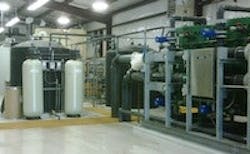Nitrate Going Green in Oklahoma Town
A thriving farming community in an area where cattle easily outnumber people, the city of Tuttle, Okla., was facing potential fines for nitrogen levels in groundwater that exceeded the maximum contaminant levels (MCL).
With sandy geology and a drinking-water aquifer lying only 25 to 30 ft beneath the surface, Tuttle is located in a low-lying river basin along the South Canadian River, just outside of Oklahoma City. The city of 6,000 was named in 1902 after cattleman J.H. (Jim) Tuttle, and the agriculture tradition continues today with cattle and dairy production as well as wheat, cotton, corn and hay.
However, nitrates from heavy agricultural operations easily percolate through the loose soil into the shallow groundwater. As a result, Tuttle’s 11 groundwater wells were producing water with between 9 to 14 parts per million (ppm) of nitrate—compared to the 10-ppm maximum.
To protect public health and avoid the possibility of being fined for MCL violations, Tuttle embarked on a multifaceted remediation program that has brought nitrate levels down to 7 ppm—well below the limit.
After enlisting an engineering consultant to study treatment options, city officials met Ron Rappard, sales engineer from Layne Christensen Co., and learned of Layne’s packed-bed, low-waste ion exchange system.
The city council considered two vendors and approved Layne’s bid due to offering the lowest waste and most cost-effective option. Layne’s advantages included the system’s high filter-loading rates, which allows for small vessels while achieving very low waste rates.
“The city of Tuttle would not have made it through last summer if we’d installed a high-waste system like an RO system,” said Steven McVicker, the city’s water superintendent.
Layne experts installed a 1,650-gal-per-minute (gpm) nitrate-treatment plant, which has a filter-loading rate of 20 to 22 gpm/sq ft—three times the standard rate of 6 to 8 gpm/sq ft used in State of Oklahoma regulations. The system uses five 48-in. diameter vessels on its treatment skids.
The regeneration process that Layne developed and uses only generates less than 0.6% waste or less, while other technologies usually generate 3 to 6% waste brine.
"Right now Layne is one of the only companies in the U.S. that can achieve these results," Rappard said.
When it came time for startup in May 2009, the Layne project manager was very helpful, McVicker said. “We had no clue how to operate a treatment system and the training was flawlessly conducted by the Layne project manager,” he explained.
The Layne technology was one small part of Tuttle’s overall project in which the city upgraded or installed 7½ miles of water mains to bring raw water from all 11 wells into one central point for treatment.
Today the blended influent averages 12 ppm and only a portion is treated to maintain a level of 7 ppm, well under the MCL of 10 ppm.
The Layne system is operating beautifully and true to Layne’s statements, “producing very little waste and is very, very low maintenance. The city of Tuttle is very pleased with the results,” McVicker said.
Ron Rappard is a sales engineer for Layne Christensen Co. Rappard can be reached at [email protected]. Lisa Culbert is marketing manager for Layne Christensen Co. Culbert can be reached at [email protected]. Matt Bokor is a consultant for Layne. Bokor can be reached at [email protected].
